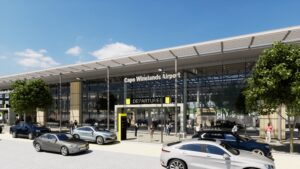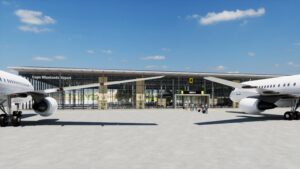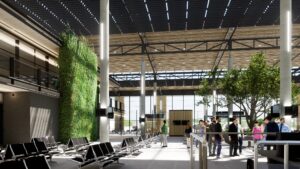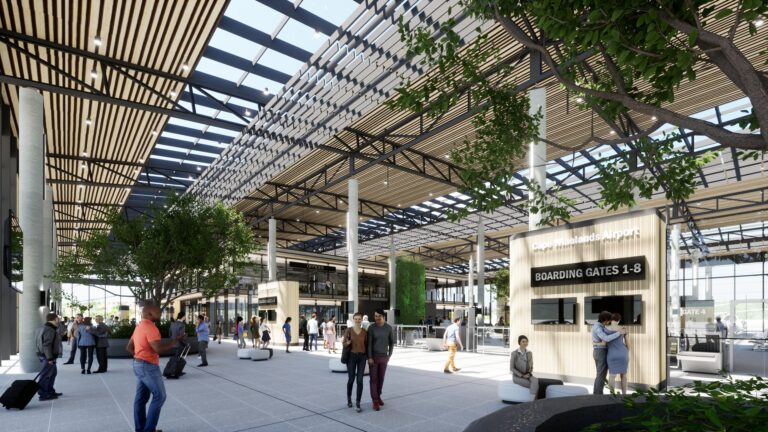 PTT speaks with Adéle Klingenberg, executive director of strategy and planning at Cape Winelands Airport in South Africa, and Marcel Langeslag, director of aviation Africa at NACO Netherlands Airport Consultants, to find out more about the insights they will share in their presentation ‘Cape Winelands Airport: fostering innovation, shared prosperity and sustainability’ at Passenger Terminal Conference 2024 in Frankfurt, Germany, this month.
PTT speaks with Adéle Klingenberg, executive director of strategy and planning at Cape Winelands Airport in South Africa, and Marcel Langeslag, director of aviation Africa at NACO Netherlands Airport Consultants, to find out more about the insights they will share in their presentation ‘Cape Winelands Airport: fostering innovation, shared prosperity and sustainability’ at Passenger Terminal Conference 2024 in Frankfurt, Germany, this month.
What is your presentation about?
We are very proud that Cape Winelands Airport (CWA) transcends conventional airport projects. Positioned amid a burgeoning growth area, CWA is set to evolve into Cape Town’s second major airport. Anticipated passenger traffic forecasts, reaching 5.2 annual passengers, combined with significant general aviation (GA), demonstrate its potential.
Additionally, CWA’s unique role as the designated alternative for Cape Town International Airport ensures operational resilience, environmental and cost savings, revenue-generating opportunities and enhanced passenger experience. CWA defines a new business case for airport development from a fuel efficiency perspective. Its integration of real estate and logistics creates a multifunctional airport city, promising enduring economic progress and empowered communities.

What can passengers expect from the new CWA? What will set it apart from other airports?
Set among the Cape Winelands, our airport will be discrete in appearance, honoring the beautiful surroundings of vineyards and fynbos, while observing the uninterrupted view of the iconic Table Mountain, one of the seven wonders of the world. To the leisure traveler, CWA will offer an airport experience where the holiday starts at the airport. It will be a destination for aviation enthusiasts with aviation attractions like engaging aero-museums. To the business traveler, CWA will offer a fast and efficient experience, using the latest technology and innovation and offering world-class business lounges and facilities. This means that we will place an emphasis on being green, smart, innovative and forward-looking.
What strategies do you have in place to ensure CWA grows into a major airport? How do you plan to boost revenue?
We believe in the co-creation of value with our current and future partners. CWA’s growth strategies have been informed by extensive consultations with the aviation industry, the surrounding communities and leaders and specialists in our region and South Africa. Through this range of consultations, the CWA team identified a very unique opportunity to position CWA as a diversion airport, which will enable the reduction of carbon emissions by approximately 5% for every flight flying into Cape Town and it will also lead to the reduction of fuel costs for airlines by approximately 5%. CWA will enable a significant positive environmental impact, improve the profitability of the route into Cape Town, stimulate the growth of new air markets and boost revenue for airlines and CWA. We believe that the merging of our aviation expertise and our extensive knowledge in commercial property expertise strengthens our value proposition and drives revenue growth.
As the emphasis on public-private partnerships grows in South Africa, CWA, as a private developer, aims to chart the way forward in demonstrating the tremendous positive impact public-private partnerships can have on growing both the regional and national economies.

What challenges has the project encountered? How have these been overcome?
Airport development is complex and requires multi-disciplinary skills and expertise. The investment required to develop an international airport of this scale is significant. Nick Ferguson, the visionary behind this development, put together a small, high-impact and agile team – all of whom have the necessary experience, having done this before, and who are able to navigate the strategic and tactical landscape. A group prepared to push the boundaries while understanding the importance of the regulatory and compliance environment. CWA’s core team boasts airport experience of well over 250 years, including strategy, policy development, corporate affairs, stakeholder management, marketing, security, engineering, finance, airport planning, and airport development, and operations.
Combined with strategic airport consulting partner NACO, there is a deep understanding of what makes airports work and what is important to success, both on the business side and the technical, infrastructure side; the need for innovative solutions and flexibility in airport plans that enable demand-driven development over time. NACO’s benchmark airport city projects have helped private airport developers across the globe diversify their revenue streams to become more resilient.
How has the airport incorporated sustainability into its design?

We have adopted an embedded sustainability approach. It is the cornerstone of who we are. Our sustainability strategy considers, among other considerations, impacts such as climate change, the role of renewable energy, social sustainability, economic sustainability and many more. Building an effective sustainability strategy is also an ongoing and evolving process. Our commitment and focus on sustainability will therefore extend beyond the design of the airport and will look well into the future as CWA operates 40-50 years from now. We hope to become a leader in sustainable airport solutions. NACO is supporting us in this journey, off-setting power requirements with on-site solar planned in harmony with the airport’s core processes, and plans for a remote digital tower that would negate the need for carbon-intensive traditional ATC tower construction, to name but a few of the innovative solutions on the anvil.
How have you futureproofed the airport’s design?
CWA appointed NACO to develop an airport master plan. We involved NACO from an early stage: they share our focus on the engagement of a wide range of stakeholders, ensuring their requirements are considered from the onset, without losing sight of the airport developer’s objectives, with plans that are tailored to CWA’s vision. NACO brought an understanding of the local context thanks to decades of working on airports in the region with local teams and combined this with a global perspective.
The team was able to draw on experience working at similar (secondary) airports around the world, as well as sustainable greenfield airport developments. Under the leadership and guidance of the NACO team, a plan was developed, supported by specialist aviation expertise, multidisciplinary in nature, ensuring a holistic approach to airport development. This included the assessment of the airspace, land use planning, master planning, traffic forecasting, analysis of diversion scenarios, advice on the latest ATM-CNS technology, and ensuring a futureproof airport for the Cape.
To register for your Passenger Terminal Conference pass, please click here.


